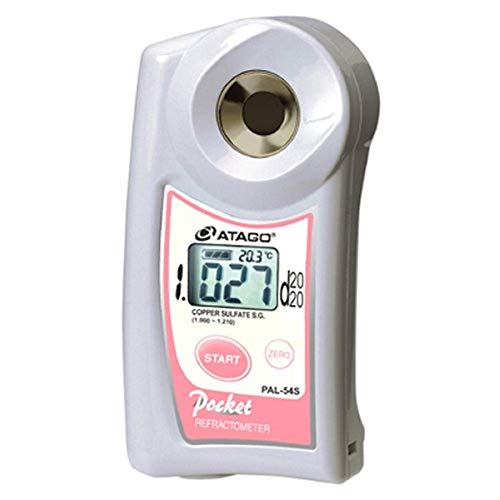


The Atago 4410 PAL-10S is a handheld, portable, water-resistant urine refractometer with a specific gravity (SG) scale that measures in the 1.000 to 1.060 range, has automatic temperature compensation (ATC), an LED display with external light interference (ELI) technology, and an acrylonitrile butadiene styrene (ABS) resin Ingress-Protection (IP-65)-rated body. A specific gravity refractometer measures the ratio of the density of a substance to the density of a reference substance, usually water for liquids, and displays the results. Handheld refractometers, also known as sugar meters, concentration meters, or Brix meters, are commonly used in the culinary, food and beverage, pharmaceutical, educational, geological, chemical, and ecological industries, and for water-testing applications.
This refractometer is housed in an ABS resin body for use with urine samples. The 4410 PAL-10S features ATC for immediate, accurate readings, with an ambient temperature range of 10 to 40 degrees C. The unit is factory-calibrated (calibration certificate not included) and can be calibrated with tap water. The metal sides of the sample well allow the sample temperature to conform quickly and evenly to the prism temperature for accurate measurements. The sloped shape eases sample pouring, and helps avoid spills while taking measurements. The outer shell is shaped for easy gripping, with raised grip dots on the back side where the fingertips rest. The LED-illuminated digital display with ELI technology helps provide accurate measurement near windows or outdoors. ELI alerts the user that there is too much light, such as direct sunlight, penetrating through the prism. The unit displays both urine SG and temperature within three seconds, and comes with a protective plastic storage case with a foam cut-out insert to cushion the instrument.
| Measurement scale range | Urine SG 1.000 to 1.060 |
| Specimen measurement temperature range | 10.0 to 35.0 degrees C |
| Accuracy | Urine SG scale + or - 0.001, Temperature + or - 1 degrees C |
| Resolution | Urine SG 0.001, Temperature 0.1 degrees C |
| Ambient temperature for unit operation | 10 to 40 degrees C |
| Sample volume | 0.3ml |
| Measurement time | Three seconds |
| Body type | ABS resin, IP-65 rated |
| Power supply | Two AAA batteries |
| Dimensions | 109 x 55 x 31mm (H x W x D) |
| Weight | 100g |
| Warranty | Limited two-year |
H is height, the vertical distance from the lowest to highest point; W is width, the horizontal distance from left to right; D is depth, the horizontal distance from front to back.
Refractometers are used to determine substance content in a sample, to provide unit readings of substances including Brix, salinity, and alcohol; to detect chemical impurities, or to measure components of samples such as industrial fluid. Refractometers measure the refractive index of a substance, which is its optical characteristic, and the number of dissolved particles in it. The refractive index is the ratio of the speed of light in empty space to the speed of light in a substance; when light passes from one medium to another. Generally, a low concentration sample has a larger angle of refraction than a high concentration sample. For example, a straw placed in a high-concentration substance appears more bent than when placed in a low-concentration substance. Refractometers can work with natural light, or with an external power source such as batteries or electricity. They typically have either a digital or analog reading display, though some units utilize both types. Some analog-display refractometers can be used for both solids and liquids. Digital-display refractometers are used exclusively for liquids. Types of refractometers include handheld, benchtop, and in-process. Handheld refractometers are elongated and telescope-shaped, or shorter and rectangular. Analog handheld refractometer readings are obtained by looking through the monocular eyepiece and viewing where the boundary line intersects with the memory line. Digital handheld models provide a digital readout. Benchtop refractometers typically measure with a higher degree of accuracy than handheld units. In-process refractometers are used for continuous process monitoring and data readouts, and are generally fitted into a piping system for ongoing analysis. Refractometers are used in a wide variety of applications in the culinary, food and beverage, pharmaceutical, educational, geological, chemical, ecological, and automotive industries, and for water-testing applications.
Atago Co., Ltd. manufactures analytical instruments such as refractometers, polarimeters, and saccharimeters, as well as a variety of meters. The company, founded in 1940 and headquartered in Tokyo, offers products that comply with Hazard Analysis and Critical Control Points (HACCP), Good Manufacturing Practices (GMP), and Good Laboratory Practices (GLP) system standards, and many International Organization for Standardization (ISO) standards.What's in the Box?
| Country | USA |
| Brand | Thomas |
| Manufacturer | Atago |
| Binding | Misc. |
| ItemPartNumber | 4410 |
| Model | ATA-4410 |
| Size | S. G. 1.000 to 1.060 |
| UnitCount | 1 |
| ReleaseDate | 0000-00-00 |